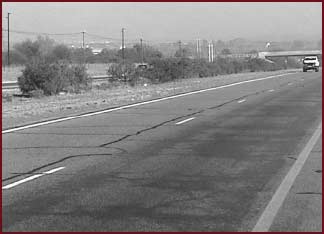U.S. Department of Transportation
Federal Highway Administration
1200 New Jersey Avenue, SE
Washington, DC 20590
202-366-4000
The scan team was provided with a wealth of information at the formal presentations, during informal discussions and gatherings, and in written documents and materials. Throughout the study, team members discussed their perceptions of what they observed in the context of which techniques and strategies used in the host countries could be practically and successfully put into place in the United States. Team members met at the end of the study to review their findings and developed the following recommendations with potential for implementation in the United States. The findings, observations, and recommendations are those of the scanning team and not FHWA.
The scanning team recommends that demonstration projects with deep subbase and deep base designs be initiated in different regions of the United States to determine the effectiveness of this design strategy.
As a first step, a seminar presenting the experience of South Africa and Australia with these design concepts would be of value. A second step would be to develop a pooled-fund study to design and construct these demonstration sections with a companion NCHRP project to monitor long-term performance. These sections should also be integrated with other recommendations in this report for thin surface treatments, including chip seals. Treatments outlined in this chapter's Chip Sealing section should be incorporated into these demonstration projects.
The countries visited made decisions to develop pavement sections that include long-life pavements. These pavements consist of deep subbase and deep base sections with a thin, high-quality wearing course to provide a good riding surface and moisture protection for the base. Pavement maintenance activities consist mainly of periodic thin surface treatments to renew the ride quality and reestablish an impervious layer. This allows for the maintenance investment to be directed to less-expensive surface treatments and not toward costly rehabilitation activities.
In addition, for major sections of the U.S. Interstate system beyond the 20-year design life, the team recommends that consideration be given to design using deep subbase and deep base sections to provide 30- and 40-year design life.
The team believes the following innovative procedures and applications have a high probability of improving the performance of chip seals in the United States.
Although chip seals are commonly used in the United States, two of the countries visited, South Africa and Australia, have developed innovative design procedures and application techniques not normally seen in the United States. Performance lives of up to 15 years are being achieved on sections with up to 60,000 vehicles per day. This outstanding performance is due in part to the deep-strength pavement designs employed.
The team recommends that highway agencies include pre-coating of chips in their chip seal specifications. Pre-coating of aggregates will improve the adhesion of chips to the binder. The South Africans use this technique on their highest-volume roads with good success.

Figure 6. The team recommends application of chip seals earlier in the distress cycle to prevent premature pavement failure.
"Guide to Geotextile-Reinforced Sprayed Seal Surfacing" (Technical Bulletin No. 38, April 2001, GeoPave) provides information and guidance for geotextile reinforcement in sprayed seal bituminous surfacing. It describes the required materials, processes, and equipment used in the application of geotextile seals in sprayed bituminous surfacing. This treatment has also been used directly on subgrade and has been successful in retarding damage to this material, provided no traffic is allowed during saturated conditions.
The team encourages agencies that do not use modified binders for chip seals to do so. Quality chip seals exhibiting long service life use bitumen modified with a variety of products. The predominant modifiers are styrene butadiene styrene, which is used extensively, and crumb rubber, which is used to a lesser degree. A unique application used in France and Australia that deserves evaluation is the use of fibers applied directly on the bitumen before the application of the cover aggregate. The fibers enhance both aggregate retention and treatment performance.
The team encourages agencies to review their specifications and upgrade them where appropriate so that superior aggregates are used and improved service life is accomplished. The success of chip seals in all the countries visited is due in large part to the high quality of the aggregate and the emphasis placed on design. High-quality aggregate (clean, less than 0.05 percent passing the 200 sieve, LA abrasion of less than 15, and micro-duval less than 20) of a single size is routinely used. In many instances, aggregate is hauled great distances, more than 500 kilometers. In addition, application rates are optimized for the type of aggregate and bitumen used.
The team encourages agencies to review their design practices for chip seals and consider placing them on base or subbase courses to prevent moisture infiltration. To prevent moisture infiltration and capillary action, the Australians often place a chip seal on the base or subbase before applying the asphalt surface. This technique is especially useful on highly moisture-susceptible bases and subbases. The Australians also perform designs to optimize application rates for the type and grade of aggregates and bitumen used.

Figure 7. The team recommends developing a national mechanism to evaluate innovative products and processes for pavement preservation.
The team recommends that chip seals be applied earlier in the distress cycle. All the countries visited try to detect cracking in the one-to-threemillimeter range, at which time a chip seal is applied. The typical U.S. treatment is to wait for visible cracks of four millimeters or greater to appear before applying a crack seal. Often, a chip seal is applied in the United States only after several years of crack sealing. Applying a chip seal earlier in the distress cycle would prevent water infiltration into the base and deter premature pavement failure. This approach may extend the life of roadway pavement structures and reduce the need for expensive rehabilitation projects.
The team recommends investigating the successful practice used in New South Wales of placing thin (40-to- 60-millimeter) asphalt overlays on existing portland cement concrete pavement. Placing thin overlays on portland cement concrete pavement has not been very successful in the United States. The Australians have designed a system specifically for this application that may provide additional preservation options for U.S. pavements. In Australia, the portland cement concrete pavement is cured with a hydrocarbon compound, followed by application of a tack coat in the normal manner.
The team recommends that AASHTO and FHWA develop a mechanism to evaluate and implement new and innovative products and processes. A national institutional process needs to be established to foster and manage innovation. This process needs to include proprietary products that private-sector investment has developed. AASHTO and FHWA also should consider the concept of risk sharing, as exemplified by the French Charter of Innovation system. This would encourage innovation by giving contractors and suppliers greater opportunities to market new technology.
The team recommends that AASHTO and/or FHWA conduct a seminar to share best practices and investigate the possibility of demonstration projects in the United States using long-term maintenance contracts. Contracting or outsourcing maintenance activities has moved to long-term contracts of three to 10 years for various types of total maintenance. These contracts are monitored for performance by means of various asset management techniques. Additional evaluation of the associated benefits of such long-term contracts for pavement preservation is needed.
The team recommends that investigation of Road Crackä and similar vehicles be conducted to fully evaluate the potential for use by transportation agencies. If warranted, the team recommends that a pilot program be developed for a side-by-side field evaluation of these vehicles.
Early and accurate detection of pavement distress is essential for an effective pavement preventive maintenance program. Transportation agencies in the United States invest significant amounts of resources in the collection of road condition information. Transportation agencies are in constant search of more efficient and cost-effective ways of collecting this information.
In New South Wales, the team learned about a high-speed pavement condition survey vehicle capable of detecting pavement cracks as small as a millimeter in width. The Road Transportation Authority of New South Wales has developed the Road Crackä vehicle that meets this need. This vehicle has the potential of saving significant resources for transportation agencies throughout the United States and other countries.
| << Previous | Contents | Next >> |